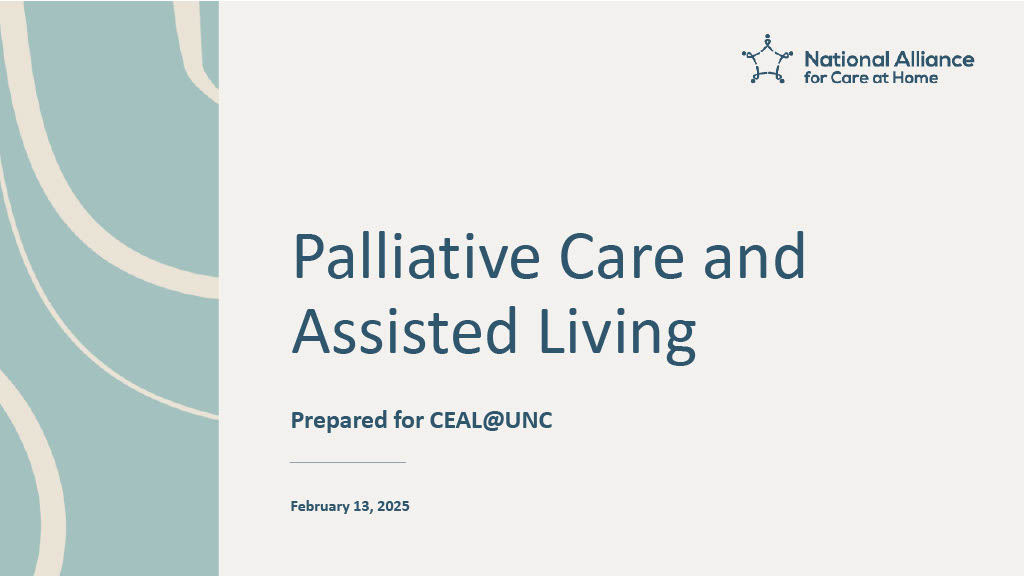CEAL@UNC regularly invites organizations and individuals committed to advancing well-being in assisted living through practice, research, and policy to present emerging and relevant topics to its Strategic Advisors. View Presentations


Center for Excellence in Assisted Living CEAL@UNC
Advancing the well-being of the people who live and work in assisted living through research, practice, and policy.

by Lea Efird-Green
by Lea Efird-Green
Objectives: Assisted living is growing in Ontario. Medical services are not regulated in Ontario, resulting in variability of physician involvement. We described medical service provider involvement and practice characteristics in assisted living homes. Design: Descriptive cross-sectional study. Setting and Participants: A total of 88 assisted living homes in Ontario, Canada, which responded to a survey […]
by Lea Efird-Green
Background: Hospice care frequently includes hands-on care from hospice aides, but the need for hospice aide care may vary in residential settings (e.g., assisted livings and nursing homes). Objectives: The objective of this study is to compare hospice aide use and factors associated with use across residential settings. Design: This longitudinal cohort study used data […]
by Lea Efird-Green
WHAT THIS MEANS FOR YOU: An analysis of 15,152 Medicare beneficiaries with ADRD examined end-of-life outcomes (mortality, hospice use, and number of days receiving hospice in the last month of life) for residents who moved to a large (25+ bed) AL between 2016 and 2018. Residents living in memory care units had a statistically significantly higher rate of mortality, higher hospice use, and more days spent receiving hospice in the last month of life than residents in general AL units.
by Lea Efird-Green
WHAT THIS MEANS FOR YOU: Using Medicare Compare and claims data for over 2800 hospice providers, this analysis found that hospices with higher AL patient volume (i.e., a higher share of their annual patient days were from AL residents) had lower quality ratings from family caregivers in key areas such as pain management, breathing help, emotional support, communication, and family training, even when controlling for profit status and daily patient census. This result indicates that hospice providers who more frequently serve AL resident patients are on average of lower quality, and more research to understand this relationship is recommended.
by Lea Efird-Green
WHAT THIS MEANS FOR YOU: Interviews and fieldnotes from 15 resident-family caregiver dyads in 3 Atlanta AL communities found that conversations about death and dying were conducted in four patterns: open discussions (both partners were talking with each other about death), blocked conversations (one partner wanted to talk about death, but the other did not), avoidance due to assumptions (each partner perceived that the other did not want to talk about death), and inability to engage in conversations due to cognitive decline or strained relationships. While 60% of residents wanted to talk about end-of-life, caregivers often avoided it.
by Lea Efird-Green
WHAT THIS MEANS FOR YOU: Medicare data from 2017 to 2020 for nearly 270,000 individuals from larger AL communities (25+ beds) found that about 35% of residents died during the study period, most often those 85 or older or with dementia. Most residents stayed in assisted living until their last year of life, but almost 20% left before their last month of life. Among those who lived in the community 30 days before death, nearly half died at the community without any healthcare transition, while over 13% had 3 or more healthcare transfers before death. Due to the prevalence of residents dying while in residence in assisted living, end-of-life practices and policies should be evaluated.
by Lea Efird-Green
WHAT THIS MEANS FOR YOU: A qualitative study in a 100-bed assisted living community catering to African American residents found that a shared belief that God was ultimately in control related to end-of-life and advance care planning preferences, although this relationship was influenced by other individual-level factors like age, pain, function, health literacy, and past experiences with healthcare.
by Lea Efird-Green
WHAT THIS MEANS FOR YOU: This study examined associations between end-of-life care transitions (meaning stays in hospitals and nursing homes in either the 7 or 30 days before death in this study) and state staffing and training requirements for nearly 114,000 Medicare beneficiaries who died in an assisted living community in 2018-2019. A higher proportion of transitions was associated with stricter regulations about licensed and direct care worker staffing, whereas a lower proportion was associated with more specific regulations about direct care worker training. Therefore, policymakers and practitioners may want to implement regulations that make staff training requirements more specific to better address end-of-life care.
by Lea Efird-Green
WHAT THIS MEANS FOR YOU: The study examined potentially burdensome end-of-life transitions (e.g., repeated hospitalizations) in relation to state regulations, using Medicare claims data for over 129,000 assisted living residents in communities with 25 or more beds between 2017-2019. There were no associations between transitions and regulations about third-party services or staffing, and small associations between transitions and medication management regulations. These inconclusive results indicate that more research is needed to understand the wide variety of end-of-life outcomes experienced by assisted living residents.
by Lea Efird-Green
WHAT THIS MEANS FOR YOU: Qualitative data from 27 administrators and 38 direct care workers in 7 assisted living communities found that when residents died, staff members balanced their personal feelings about death and their work role in a process called “managing the normalization of death” with varying levels of perceived success. Additional resources and training about managing resident death, including improved collaboration with hospice services and clearer end-of-life care policies, might be helpful for staff.
by Lea Efird-Green
WHAT THIS MEANS FOR YOU: Medicare data from nearly 170,000 residents from over 8,000 assisted communities with more than 25 beds who died between 2017 and 2019 indicated that in states with regulations supportive of third-party hospice services, residents were significantly more likely to die in assisted living than in a hospital or nursing home.
by Lea Efird-Green
Successful aging among independent community-dwelling older adults and those in residential settings is paramount to aging in place. The purpose of the current study was to explore how sensory, cognitive, and functional impairments affect successful aging in assisted living (AL) settings. Vision compromise was noted for near visual acuity (NVA) (14.3%) and distance visual acuity […]
by Lea Efird-Green
WHAT THIS MEANS FOR YOU: Medicare data from 23,000 residents in more than 6,000 assisted living communities found that 56% received hospice care during their last month of life. Communities in states with more supportive hospice regulations had significantly more hospice use, especially a more intense type called continuous home care (CHC). Modifications to state regulations to be more supportive of hospice care/CHC might increase the number of residents who use hospice, which might improve quality of life in the days immediately preceding death.
by Lea Efird-Green
WHAT THIS MEANS FOR YOU: This study examined end-of-life care in assisted living – specifically whether residents died in the community or elsewhere and received hospice care — and whether these were associated with select factors. Among 100,783 Medicare beneficiaries who died in 16,560 communities during 2018–2019, nearly 60% died in their community, with 84% receiving hospice care. Communities with more Medicare-Medicaid enrollment had more residents dying in the community, and white residents were more likely than Black ones to use hospice care. In states with less strict assisted living regulations (e.g., for dementia care, admission/retention, and staffing/training), residents were more likely to die outside of the community (e.g., in a hospital or nursing home).
by Lea Efird-Green
WHAT THIS MEANS FOR YOU: This qualitative study of observation and 61 interviews with assisted living residents, family members, staff, and external care workers in one large community in Atlanta, found that while sharing health information could strengthen social bonds among residents, there were concerns about privacy; for example, when inappropriate public exchanges occurred, they hindered social relationship building. Barriers to communicating health information contributed to resident isolation, but negotiating privacy boundaries to share such information may promote resident wellbeing.
by Lea Efird-Green
WHAT THIS MEANS FOR YOU: In a qualitative study including interviews with 18 residents in 21 assisted living communities, as well as reviews of community documents and observational field notes, residents reported that staff communication and community-level memorials following residents’ death were not consistent with a “family-like” atmosphere, and residents’ grief took many forms.
by Lea Efird-Green
WHAT THIS MEANS FOR YOU: Interviews with 27 AL administrators revealed different approaches to advanced care planning (ACP). They all acknowledged the importance of ACP and often discussed topics like “do-not-resuscitate” orders when new residents arrived. Challenges included insufficient ACP training for staff and administrators and some reluctance from residents and families to discuss ACP. Most communities lacked a systematic, structured ACP approach.
by Lea Efird-Green
WHAT THIS MEANS FOR YOU: There are significant differences in the quality of end-of-life care in AL. Research on 37,668 deceased Medicare beneficiaries who lived in AL found that 1 in 5 experienced challenging transitions including frequent hospitalizations before their death. Burdensome transitions, especially in the last three days of life, varied widely among states, which may be associated with state-level regulations.